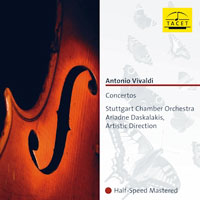Vivaldi • Concertos
 cholars
rediscovered Vivaldi’s music in the 20th century as an outgrowth of searching for
Bach's influences. It wasn’t until mid-century that modern music lovers began to take
notice of the composer, in part thanks to Charles Munchinger’s Stuttgart Chamber
Orchestra (SCO) and their 1959 gold-standard recording of Vivaldi’s The Four
Seasons on Decca. Nowadays, Vivaldi’s music is everywhere, and here the SCO
performs it with consummate skill and a zesty enjoyment that befit the orchestra's
heritage. cholars
rediscovered Vivaldi’s music in the 20th century as an outgrowth of searching for
Bach's influences. It wasn’t until mid-century that modern music lovers began to take
notice of the composer, in part thanks to Charles Munchinger’s Stuttgart Chamber
Orchestra (SCO) and their 1959 gold-standard recording of Vivaldi’s The Four
Seasons on Decca. Nowadays, Vivaldi’s music is everywhere, and here the SCO
performs it with consummate skill and a zesty enjoyment that befit the orchestra's
heritage.
Unlike a Classical Period concerto that typically features a single soloist, each of Vivaldi’s four works on this Tacet album includes the orchestra with multiple soloists: two violins, three violins, violin and cello, or two cellos. Guest artistic director and soloist on two concertos, Ariadne Daskalakis brings period technique to the modern ensemble. Her pace is brisk with dynamic emphasis and crisp attack. Vivaldi adopted his standard three-movement ritornello structure for each work. In the generally snappy outer movements, the orchestra alternates with episodes for the soloists, while the middle movements run at varying slower speeds. Here the soloists receive ingenuous and sublime opportunities to play off and with one another. I found the gentle pizzicato intricacies of the melodic second movement in the Concerto for Three Violins particularly compelling. This is music for an afternoon in the shade with light refreshment, after the rain has cleared and the air is freshened. The outer movements of the Concerto for Two Violoncellos are vigorously driven with technical virtuosity from both cellists, and they sandwich a sweetly melancholic Largo. Despite their similarity in structure, the unique compositions, not to mention the varying orchestration, make each concerto a treat to hear. To deliver this LP gem, Tacet’s Andreas Spreer called on his 25-plus years of recording experience to go with his use of half-speed mastering. The master tape plays back at 16 2/3 RPM, giving the record lathe’s cutting head twice the amount of time to chisel out the analog groove. This improves accuracy and imbues more information in the vinyl, particularly for higher frequencies. The cutting head only needs to go to 10kHz to cut 20kHz; Tacet can cut up to 40kHz. Without subterranean lows, chamber music with well mic’d strings is an ideal candidate for half-speed mastering. The trick, as Spreer notes, is "bending" the RIAA curve just so during cutting to avoid audible tonal colorations on playback -- a limitation of the technique in the 1970s, '80s and '90s, when real-time frequency correction was hit and miss, or not done at all. Spreer developed what he coyly calls "a tool" to do the job right, and the results are evident. Tacet’s new recording of Vivaldi concertos is as
fine an example of the vinyl medium as I’ve spun on my turntable this century. The
music is interesting and delightful, the performances are top-shelf, and the sonics are
the kind audiophiles truly appreciate: A wide soundstage offers easily identified
instruments, delivering a crisp dynamic performance. Exquisite yet creamy highs and rich
harmonics abound across a clear and direct presentation in a naturally (but not overly)
reverberant church. We don’t usually think of Vivaldi’s works as showcase
compositions, but if you like Baroque music, this collection is as good as it gets. |
